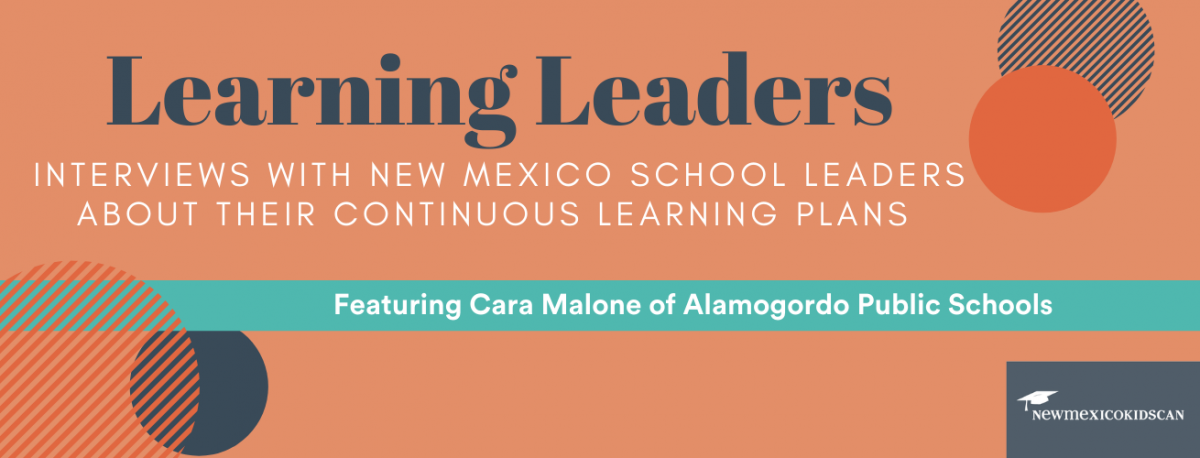For this week of Learning Leaders, we interviewed Cara Malone, the deputy superintendent of Alamogordo Public Schools.
Alamogordo Public Schools is made up of fourteen schools located in Alamogordo, New Mexico. 52.6% of students attending Alamogordo identify as students of color and 58.9% of students qualify for free or reduced lunch. Alamogordo is also the hub of Holloman Air Force and the school system supports many military families.
How did you develop your continuous learning plan?
Malone and her team began developing their continuous learning plan when the idea of schools closing was just a possibility. They spent weeks discussing how to provide students with technology and digital access, while also figuring out what to do for students with no connectivity. One of their priorities was to ensure that their plan fit the needs of their students and teachers, so they wanted to keep it as simple as possible. The district wanted to avoid creating a plan that utilized too many programs/platforms or complicated schedules, as they felt that it could overwhelm students and families.
What has been the most challenging part of switching to distance learning?
Malone said that the switch to distance learning has not been nearly as difficult as she thought it would be. Distance learning is different and takes some getting used to, but Malone believes that the transition has been easier in large part because the teachers have handled the transition well. Malone says the most challenging aspect is not being able to interact with students face-to-face. Although, the district has mitigated this as best as possible by offering many opportunities a day for administrators, teachers, and students to see each other via Google Hangouts.
What do you think are the best aspects of your continuous learning plan?
Malone believes that the best aspect of their plan is how specific, simple, and actionable it is. Before distance learning began, some teachers were concerned about providing students with a beneficial educational experience from home. As a response, Malone said that they didn’t expect perfection from teachers and told them, “Let’s just let go and teach.” By taking the focus off of grades, their plan allows teachers to focus more on engaging students, expanding student’s skills and supporting growth.
Have you had to make any adjustments to your plan since starting distance learning?
Malone said that they haven’t had to make any major changes to their plan, but they have had to make some adjustments. One such adjustment made was to change the way the schools were providing assignments to students with no internet access. In order to support students with technology devices but no internet, the district is providing assignments that can be done without Internet access. Students originally could download these assignments at meal pickups, but they found this to be too difficult. To resolve this problem, the district started downloading the assignments to flash drives that were even delivered to some homes. Only as a last resort, the school offers paper packets for students. This is the least desirable option as the student retention is decreased and it is difficult to receive the packets back.
The district as a whole has made some schedule adjustments to their plan, too. Students at Alamogordo have a minimum of two Google Hangout sessions to attend each week plus a video lesson and activity two to three times per week. Malone recognized the difficulty for some students to attend meetings because they are a part of families with multiple students in different grades with only one device. Because of that, some schools have changed their meetings to later in the afternoon to avoid overlapping schedules, but they have also emphasized that it is okay if students are unable to attend every meeting. Every meeting is recorded, so if students only attend some meetings, they still have the ability to view the ones they missed at a later time.
Were there any continuous learning plans from other schools in New Mexico or the country that you referred to when developing your plan?
Malone reached out to colleagues inside and outside of New Mexico about what they were doing for their plans. She also kept an eye out for what other New Mexico schools were doing, but she noticed that Alamogordo’s plan was one of the first published.
What has been the most helpful tool that you/your school is utilizing? Why?
Malone said that their continuous learning plan as a whole has been very useful, but the school principals have been extremely helpful as well. Principals of schools do surprise “pop-ins” where they sit in on meetings with teachers and students to ensure that their expectations are being met. The district has also implemented a distance learning coaching model for teachers. These coaches helped communicate expectations to teachers, while also working around the clock to support teachers with whatever help they might need.
What has student/parent/teacher feedback been like?
Along with their previously established support system, the district is also sending out teacher satisfaction surveys to see how they feel. Parents have been reaching out with nice comments, especially during Teacher Appreciation Week. A few parents have felt overwhelmed but the community has mainly been supportive. Malone said that the district tries to resolve any negative feedback when it arises, rather than letting it develop into a bigger issue. Principals try to work through issues or concerns with parents directly. The district also has a technology hotline with a real person to talk to, which is a great tool for feedback or troubleshooting issues from families.
Will remote learning contribute to a change the way your district operates when school resumes? If so, how?
Assuming that school resumes as normal in August, Malone said that the district has already made the decision to incorporate Google Classroom into the regular curriculum. The district is considering “Paperless Wednesdays,” which are late start/early release days of school, so they are a good day to focus on doing things differently. Malone believes that having one day a week for digital learning will set the school district up for great things, such as being more prepared for sudden changes in learning.
In your opinion, how will this impact education in the future?
When asked this question, Malone mentioned how a common criticism of the current educational system in the United States is that it is an outdated model, but school closures have brought a much-needed update to the system. Malone believes that allowing more opportunities for connection and collaboration will change the way people work, and she has seen this in her own district with weekly collaborative teacher meetings. Malone also believes that school closures have highlighted the need for learning flexibility for students. While some students prefer regular schooling, Malone noticed that some students have come to embrace virtual learning. Different students need different ways of learning. The education system should differentiate and offer more alternative types of learning than what we have come to know as the one size fits all standard.
We would like to thank Mrs. Malone for taking the time to talk to us! To learn more information about Alamogordo Public Schools, you can find their website here.

